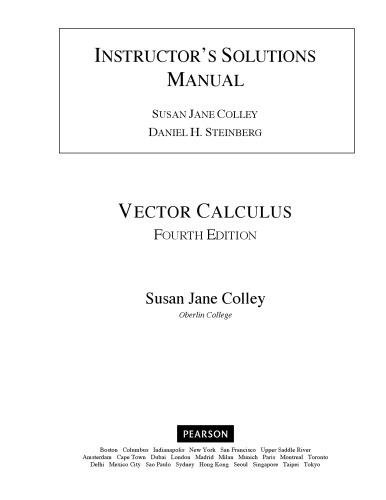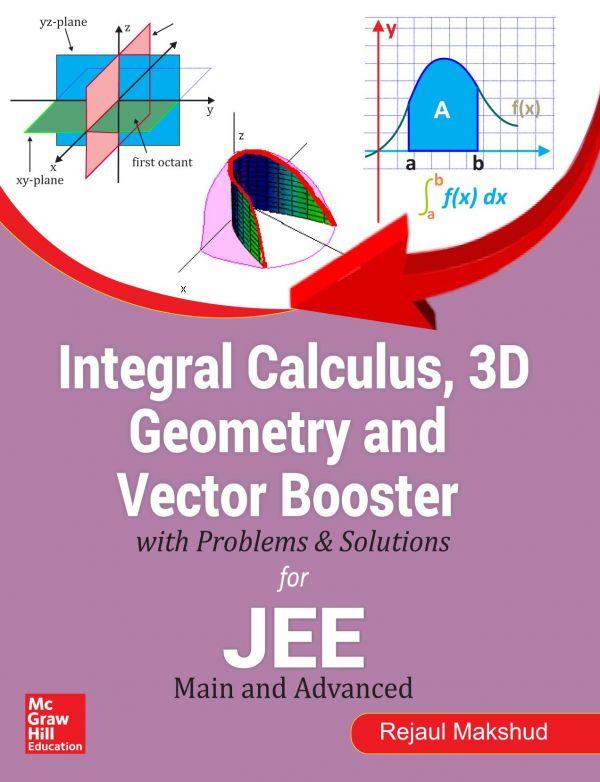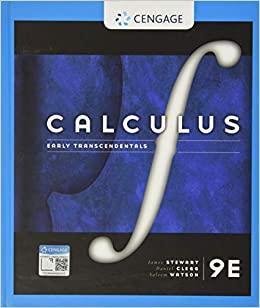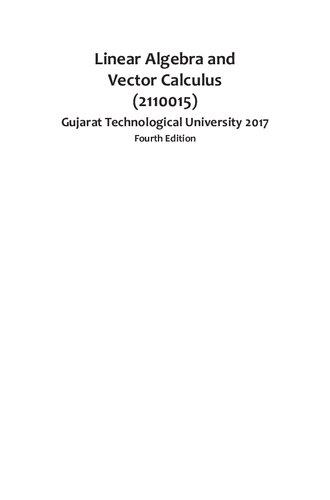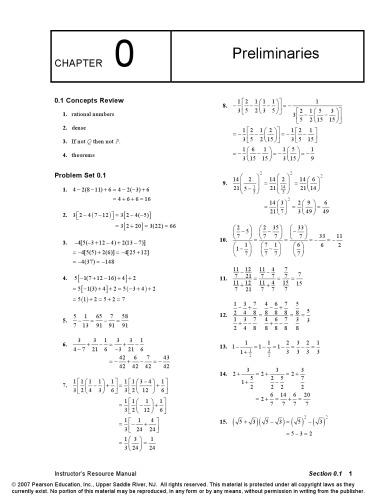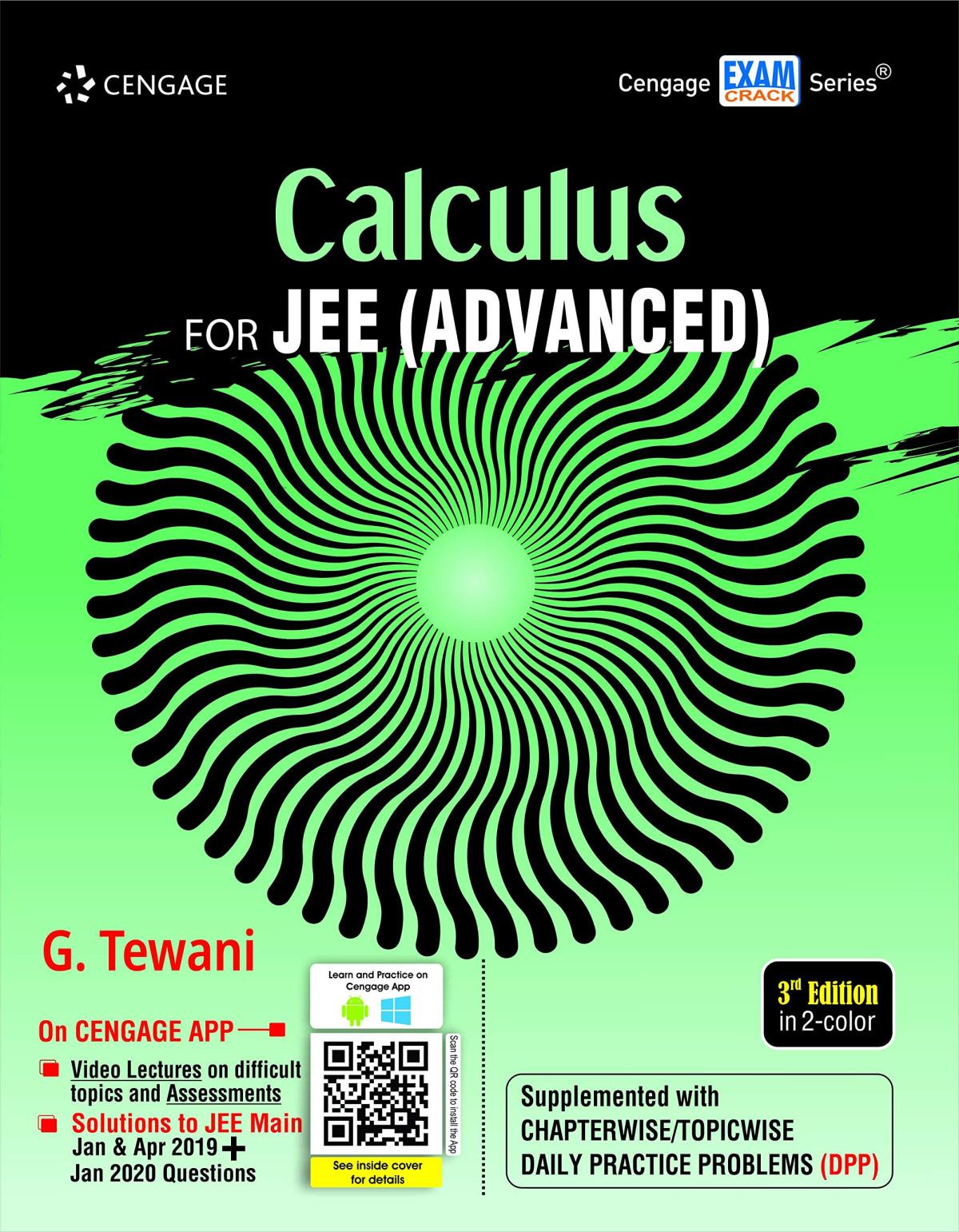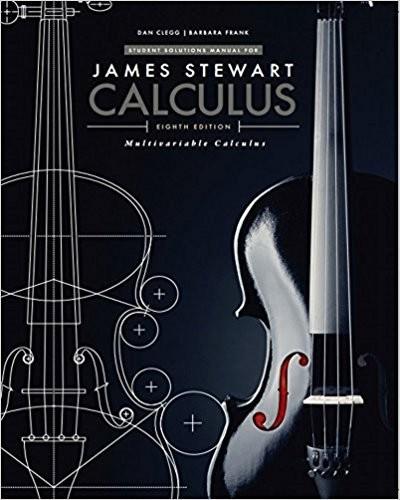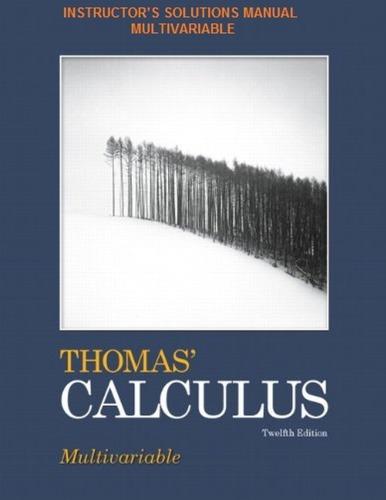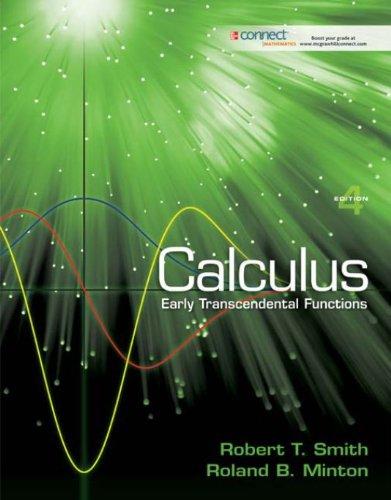Chapter1
Vectors
1.1VectorsinTwoandThreeDimensions
1. Herewejustconnectthepoint(0,0)tothepointsindicated :
2. Althoughmoredifficultforstudentstorepresentthisonpaper,the figuresshouldlooksomethinglikethefollowing.Notethat theoriginisnotatacorneroftheframeboxbutisatthetailsofthethreevectors
Inproblems3and4,wesupplymoredetailthanisnecessarytostresstostudentswhatpropertiesarebeingused :
3.(a) (3, 1)+( 1, 7)=(3+[ 1], 1+7)=(2, 8)
(b) 2(8, 12)=( 2 8, 2 12)=( 16, 24).
(c) (8, 9)+3( 1, 2)=(8+3( 1), 9+3(2))=(5, 15)
(d) (1, 1)+5(2, 6) 3(10, 2)=(1+5 2 3 10, 1+5 6 3 2)=( 19, 25)
(e) (8, 10)+3((8, 2) 2(4, 5))=(8+3(8 2 4), 10+3( 2 2 5))=(8, 26)
4.(a) (2, 1, 2)+( 3, 9, 7)=(2 3, 1+9, 2+7)=( 1, 10, 9)
(b) 1 2 (8, 4, 1)+2 5, 7, 1 4 = 4, 2, 1 2 + 10, 14, 1 2 =(14, 12, 1)
(c) 2 (2, 0, 1) 6 1 2 , 4, 1 = 2((2, 0, 1) (3, 24, 6))= 2( 1, 24, 5)=(2, 48, 10)
5. Westartwiththetwovectors a and b.Wecancompletetheparallelogramasinthe figureontheleft.Thevectorfromthe origintothisnewvertexisthevector a + b.Inthe figureontherightwehavetranslatedvector b sothatitstailistheheadof vector a.Thesum a + b isthedirectedthirdsideofthistriangle.
6. a =(3, 2) b =( 1, 1) a b =(3 ( 1), 2 1)=(4, 1)
, 4)
7.(a) → AB =( 3 1, 3 0, 1 2)=( 4, 3, 1) → BA
AB =(4, 3, 1) (b) → AC =(2 1, 1 0, 5 2)=(1, 1, 3) → BC =(2 ( 3), 1 3, 5 1)=(5, 2, 4) → AC + → CB =(1, 1, 3) (5, 2, 4)=( 4, 3, 1) (c) Thisresultistrueingeneral:
Head-to-tailadditiondemonstratesthis.
8. Thevectors a =(1, 2, 1), b =(0, 2, 3) and a + b =(1, 2, 1)+(0, 2, 3)=(1, 0, 4) aregraphedbelow. Againnotethat theoriginisatthetailsofthevectorsinthe figure
Also, 1(1, 2, 1)=( 1, 2, 1).Thiswouldbepicturedbydrawingthevector(1,2,1)intheoppositedirection. Finally, 4(1, 2, 1)=(4, 8, 4) whichisfourtimesvector a andsoisvector a stretchedfourtimesaslonginthesamedirection.
9. Sincethesumontheleftmustequalthevectorontherightcomponentwise: 12+ x =2, 9+7= y ,and z + 3=5.Therefore, x =14, y =16,and z =8
10. Ifwedropaperpendicularfrom(3,1)tothe x-axisweseethatbythePythagoreanTheoremthelengthofthevector (3, 1)= √32 +12 = √10
11. Noticethat b (representedbythedottedline) =5a (representedbythesolidline).
12. Herethepicturehasbeenprojectedintotwodimensionssothatyoucanmoreclearlyseethat a (representedbythesolid line) = 2b (representedbythedottedline).
13. Thenaturalextensiontohigherdimensionsisthatwestilladdcomponentwiseandthatmultiplyingascalarbyavectormeans thatwemultiplyeachcomponentofthevectorbythescalar.Insymbolsthismeansthat: a + b =(a1 ,a2 ,...,an )+(b1 ,b2 ,...,bn )=(a1 + b1 ,a2 + b2 ,...,an + bn ) and k a =(ka1 ,ka2 ,...,kan )
Inourparticularexamples, (1, 2, 3, 4)+(5, 1, 2, 0)=(6, 1, 5, 4),and 2(7, 6, 3, 1)=(14, 12, 6, 2)
14. Thediagramsforparts(a),(b)and(c)aresimilartoFigure1.12fromthetext.Thedisplacementvectorsare:
(a) (1,1,5)
(b) ( 1, 2, 3)
(c) (1, 2, 3)
(d) ( 1, 2)
Note:Thedisplacementvectorsfor(b)and(c)arethesamebutinoppositedirections(i.e.,oneisthenegativeofthe other).Thedisplacementvectorinthediagramfor(d)isrepresentedbythesolidlineinthe figurebelow:
15. Ingeneral,wewoulddefinethedisplacementvectorfrom (a1 ,a2 ,...,an ) to (b1 ,b2 ,...,bn ) tobe (b1 a1 ,b2 a2 ,...,bn an )
Inthisspecificproblemthedisplacementvectorfrom P1 to P2 is (1, 4, 1, 1).
16. Let B havecoordinates(x, y , z ).Then −→ AB =(x 2,y 5,z +6)=(12, 3, 7) so x =14, y =2, z =1 so B has coordinates(14,2,1).
17. If a isyourdisplacementvectorfromtheEmpireStateBuildingand b yourfriend’s,thenthedisplacementvectorfromyou toyourfriendis b a.
18. Property2followsimmediatelyfromtheassociativepropertyofthereals:
Property3alsofollowsfromthecorrespondingcomponentwiseobservation:
19. Weprovidetheproofsfor R3 : (1)(k + l )a =(k + l )(a1 ,a2 ,a3 )=((k + l )a1 , (k + l )a2 , (k + l )a3 ) =(ka1 + la1 ,ka2 + la2 ,ka3 + la3 )= k a + l a (2) k (a + b)= k ((a1 ,a2 ,a3 )+(b1 ,b2 ,b3 ))= k (a1 + b1 ,a2 + b2 ,a3 + b3 ) =(k (a1 + b1 ),k (a2 + b2 ),k (a3 + b3 ))=(ka1 + kb1 ,ka2 + kb2 ,ka3 + kb3 ) =(ka1 ,ka2 ,ka3 )+(kb1 ,kb2 ,kb3 )= k a + k b (3) k (l a)= k (l (a1 ,a2 ,a3 ))= k (la1 ,la2 ,la3 ) =(kla1 ,kla2 ,kla3 )=(lka1 ,lka2 ,lka3 ) = l (ka1 ,ka2 ,ka3 )= l (k a)
20.(a) 0a isthezerovector.Forexample,in R3 :
(b) 1a = a.Againin R3 : 1
21.(a) Theheadofthevector sa isonthe x-axisbetween0and2.Similarlytheheadofthevector tb liessomewhereonthe vector b.Usingthehead-to-tailmethod, sa + tb istheresultoftranslatingthevector tb,inthiscase,totherightby2s (representedinthe figureby tb*).Theresultisclearlyinsidetheparallelogramdeterminedby a and b (andisonlyonthe boundaryoftheparallelogramifeither t or s is0or1.
(b) Againthevectors a and b willdetermineaparallelogram(withverticesattheorigin,andattheheadsof a, b,and a + b Thevectors sa + tb willbethepositionvectorsforallpointsinthatparallelogramdeterminedby(2,2,1)and(0,3,2).
22. HerewearetranslatingthesituationinExercise21bythevector → OP0 .Thevectorswillallbeoftheform → OP0 + sa + tb for 0 ≤ s,t ≤ 1
23.(a) Thespeedofthe fleaisthelengthofthevelocityvector = ( 1)2 +( 2)2 = √5 unitsperminute.
(b) After3minutesthe fleaisat (3, 2)+3( 1, 2)=(0, 4)
(c) Wesolve (3, 2)+ t( 1, 2)=( 4, 12) for t andgetthat t =7 minutes.Notethat both 3 7= 4 and 2 14= 12
(d) Wecanseethisalgebraicallyorgeometrically:Solvingthe x partof (3, 2)+ t( 1, 2)=( 13, 27) wegetthat t =16.Butwhen t =16, y = 30 not 27.Alsointhe figurebelowweseethepathtakenbythe fleawillmissthe point ( 13, 27).
24.(a) Theplaneisclimbingatarateof4milesperhour.
(b) Tomakesurethattheaxesareorientedsothattheplanepassesoverthebuilding,thepositive x directioniseastandthe positive y directionisnorth.Thenweareheadingeastatarateof50milesperhouratthesametimewe’reheadingnorth atarateof100milesperhour.Wearedirectlyovertheskyscraperin1/10ofanhouror6minutes.
(c) Usingouranswerin(b),wehavetraveledfor1/10ofanhourandsowe’veclimbed4/10ofamileor2112feet.Theplane is 2112 1250 or862feetabouttheskyscraper.
25.(a) Addingweget: F1 + F2 =(2, 7, 1)+(3, 2, 5)=(5, 5, 4)
(b) Youneedaforceofthesamemagnitudeintheoppositedirection,so F3 = (5, 5, 4)=( 5, 5, 4)
26.(a) Measuringtheforceinpoundsweget (0, 0, 50)
(b) The z componentsofthetwovectorsalongtheropesmustbeequalandtheirsummustbeoppositeofthe z component inpart(a).Their y componentsmustalsobeoppositeeachother.Sincethevectorpointsinthedirection(0, ±2,1), the y componentwillbetwicethe z component.Togetherthismeansthatthevectorinthedirectionof (0, 2, 1) is (0, 50, 25) andthevectorinthedirection(0,2,1)is(0,50,25).
27. Theforce F duetogravityontheweightisgivenby F =(0, 0, 10).Theforcesalongtheropesareeachparalleltothe displacementvectorsfromtheweighttotherespectiveanchorpoints.Thatis,thetensionvectorsalongtheropesare
F1 = k ((3, 0, 4) (1, 2, 3))= k (2, 2, 1)
F2 = l ((0, 3, 5) (1, 2, 3))= l ( 1, 1, 2), where k and l areappropriatescalars.Fortheweighttoremaininequilibrium,wemusthave F1 + F2 + F = 0,or,equivalently, that k (2, 2, 1)+ l ( 1, 1, 2)+(0, 0, 10)=(0, 0, 0). Takingcomponents,weobtainasystemofthreeequations:
+2l =10
Solving,we findthat k =2and l =4,sothat F1 =(4, 4, 2) and F2 =( 4, 4, 8)
1.2MoreaboutVectors
ItmaybeusefultopointoutthattheanswerstoExercises1and5arethe“same”,butthatinExercise1, i =(1, 0) andinExercise 5, i =(1, 0, 0).ThiscomesupwhengoingtheotherdirectioninExercises9and10.Inotherwords,it’snotalwaysclearwhether theexercise“lives”in R2 or R3
1. (2, 4)=2(1, 0)+4(0, 1)=2i +4j
2. (9, 6)=9(1, 0) 6(0, 1)=9i 6j
3. (3,π, 7)=3(1, 0, 0)+ π (0, 1, 0) 7(0, 0, 1)=3i + π j 7k.
4. ( 1, 2, 5)= 1(1, 0, 0)+2(0, 1, 0)+5(0, 0, 1)= i +2j +5k.
5. (2, 4, 0)=2(1, 0, 0)+4(0, 1, 0)=2i +4j.
6. i + j 3k =(1, 0, 0)+(0, 1, 0) 3(0, 0, 1)=(1, 1, 3)
7. 9i 2j + √2k =9(1, 0, 0) 2(0, 1, 0)+ √2(0, 0, 1)=(9, 2, √2)
8. 3(2i 7k)= 6i +21k = 6(1, 0, 0)+21(0, 0, 1)=( 6, 0, 21)
9. π i j = π (1, 0) (0, 1)=(π, 1)
10. π i j = π (1, 0, 0) (0, 1, 0)=(π, 1, 0)
Note:YoumaywanttoassignbothExercises11and12togethersothatthestudentsmayseethedifference.Youshouldstress thatthereasontheresultsaredifferenthasnothingtodowiththefactthatExercise11isaquestionabout R2 whileExercise12is aquestionabout R3
11.(a) (3, 1)= c1 (1, 1)+ c2 (1, 1)=(c1 + c2 ,c1 c2 ),so c1 + c2 =3, and c1 c2 =1
Solvingsimultaneously(forinstancebyaddingthetwoequations),we findthat 2c1 =4,so c1 =2 and c2 =1.So b =2a1 + a2 (b) Here c1 + c2 =3 and c1 c2 = 5,so c1 = 1 and c2 =4.So b = a1 +4a2 (c) Moregenerally, (b1 ,b2 )=(c1 + c2 ,c1 c2 ),so c1 + c2 = b1 , and c1 c2 = b2
Againsolvingsimultaneously, c
12. Notethat a3 = a1 + a2 ,soreallyweareonlyworkingwithtwo(linearlyindependent)vectors. (a) (5, 6, 5)= c1 (1, 0, 1)+ c2 (0, 1, 0)+ c3 (1, 1, 1);thisgivesustheequations:
The firstandlastequationscontainthesameinformationandsowehaveinfinitelymanysolutions.Youwillquicklysee onebyletting c3 =0.Then c1 =5 and c2 =6.Sowecouldwrite b =5a1 +6a2 .Moregenerally,youcanchooseany valuefor c1 andthenlet c2 = c1 +1 and c3 =5 c1 (b) Wecannotwrite(2,3,4)asalinearcombinationof a1 , a2 ,and a3 .Herewegettheequations:
c1 + c3 =2 c2 + c3 =3 c1 c3 =4
The firstandlastequationsareinconsistentandsothesystemcannotbesolved. (c) Aswesawinpart(b),notallvectorsin R3 canbewrittenintermsof a1 , a2 ,and a3 .Infact,onlyvectorsoftheform (a,b, a) canbewrittenintermsof a1 , a2 ,and a3 .Foryourstudentswhohavehadlinearalgebra,thisisbecausethe vectors a1 , a2 ,and a3 arenotlinearlyindependent.
Note:Aspointedoutinthetext,theanswersfor13–21arenotunique.
13. r(t)=(2, 1, 5)+ t(1, 3, 6) so ⎧ ⎨ ⎩ x =2+ t y = 1+3t z =5 6t.
14. r(t)=(12, 2, 0)+ t(5, 12, 1) so ⎧ ⎨ ⎩ x =12+5t y = 2 12t z = t.
15. r(t)=(2, 1)+ t(1, 7) so x =2+ t y = 1 7t.
16. r(t)=(2, 1, 2)+ t(3 2, 1 1, 5 2) so ⎧ ⎨ ⎩ x =2+ t y =1 2t z =2+3t.
17. r(t)=(1, 4, 5)+ t(2 1, 4 4, 1 5) so ⎧ ⎨ ⎩ x =1+ t y =4 z =5 6t.
18. r(t)=(8, 5)+ t(1 8, 7 5) so x =8 7t y =5+2t.
Note:Inhigherdimensions,weswitchournotationto xi
19. r(t)=(1, 2, 0, 4)+ t( 2, 5, 3, 7) so ⎧ ⎪ ⎪ ⎨ ⎪ ⎪ ⎩ x1 =1 2t x2 =2+5t x3 =3t x4 =4+7t.
20. r(t)=(9,π, 1, 5, 2)+ t( 1 9, 1 π, √2+1, 7 5, 1 2) so
21.(a) r(t)=( 1, 7, 3)+ t(2, 1, 5) so ⎧ ⎨ ⎩ x = 1+2t y =7 t z =3+5t.
(b) r(t)=(5, 3, 4)+ t(0 5, 1+3, 9 4) so ⎧
x =5 5t y = 3+4t z =4+5t.
x1 =9 10t x2 = π +(1 π )t x3 = 1+(√2+1)t x4 =5+2t x5 =2 t.
(c) Ofcourse,thereareinfinitelymanysolutions.Forourvariationontheanswerto(a)wenotethatalineparalleltothe vector 2i j +5k isalsoparalleltothevector (2i j +5k) soanothersetofequationsforpart(a)is:
x = 1 2t y =7+ t z =3 5t.
Forourvariationontheanswerto(b)wenotethatthelinepassesthroughbothpointssowecansetuptheequationwith respecttotheotherpoint:
x = 5t y =1+4t z =9+5t.
(d) Thesymmetricformsare: x +1 2 =7 y = z 3 5 (for(a)) 5 x 5 = y +3 4 = z 4 5 (for(b)) x +1 2 = y 7= z 3 5 (forthevariationof(a)) x 5 = y 1 4 = z 9 5 (forthevariationof(b))
22. Solvefor t ineachoftheparametricequations.Thus
andthesymmetricformis
23. Solvingfor t ineachoftheparametricequationsgives t = x 7, t =(y +9)/3,and t =(z 6)/( 8),sothatthesymmetric formis
24. Seteachpieceoftheequationequalto t andsolve:
25. Let t =(x +5)/3.Then x =3t 5.Inviewofthesymmetricform,wealsohavethat t =(y 1)/7 and t =(z +10)/( 2) Henceasetofparametricequationsis x =3t 5, y =7t +1,and z = 2
Note:InExercises26–29,wecouldsayforcertainthattwolinesarenotthesameifthevectorswerenotmultiplesofeach other.Inotherwords,ittakestwopiecesofinformationtospecifyaline.Youeitherneedtwopoints,orapointandadirection(or inthecaseof R2 ,equivalently,aslope)
26. The firstlineisparalleltothevector a1 =(5, 3, 4),whilethesecondisparallelto a2 =(10, 5, 8).Since a1 and a2 are notparallel,thelinescannotbethesame.
27. Ifwemultiplyeachofthepiecesinthesecondsymmetricformby 2,weareeffectivelyjusttraversingthesamepathata differentspeedandwiththeoppositeorientation.Sothesecondsetofequationsbecomes:
Thislooksalotmorelikethe firstsetofequations.Ifwenowsubtractonefromeachpieceofthesecondsetofequations(as suggestedinthetext),weareeffectivelyjustchangingourinitialpointbutwearestillonthesameline:
Wehavetransformedthesecondsetofequationsintothe firstandthereforeseethattheybothrepresentthesamelinein R3 .
28. Ifyou firstwritetheequationofthetwolinesinvectorform,wecanseeimmediatelythattheirdirectionvectorsarethesame soeithertheyareparallelortheyarethesameline:
r1 (t)=( 5, 2, 1)+ t(2, 3, 6) r2 (t)=(1, 11, 17) t(2, 3, 6).
The firstlinecontainsthepoint ( 5, 2, 1).Ifthesecondlinecontains ( 5, 2, 1),thentheequationsrepresentthesameline. Solvejustthe x componenttogetthat 5=1 2t ⇒ t =3.Checkingweseethat r2 (3)=(1, 11, 17) 3(2, 3, 6)= ( 5, 2, 1) sothelinesarethesame.
29. Hereagainthevectorformsofthetwolinescanbewrittensothatweseetheirheadingsarethesame:
r1 (t)=(2, 7, 1)+ t(3, 1, 5)
r2 (t)=( 1, 8, 3)+2t(3, 1, 5)
Thepoint (2, 7, 1) isonlineone,sowewillchecktoseeifitisalsoonlinetwo.AsinExercise28wechecktheequationfor the x componentandseethat 1+6t =2 ⇒ t =1/2.Checkingweseethat r2 (1/2)=( 1, 8, 3)+(1/2)(2)(3, 1, 5)= (2, 7, 2) =(2, 7, 1) sotheequationsdonotrepresentthesamelines.
Note:ItisagoodideatoassignbothExercises30and31together.Althoughtheylooksimilar,thereisadifferencethat studentsmightmiss.
30. Ifyoumakethesubstitution u = t3 ,theequationsbecome:
x =3u +7, y = u +2, and z =5u +1
Themap u = t3 isabijection.Theimportantfactisthat u takesonexactlythesamevaluesthat t does,justatdifferenttimes. Since u takesonallreals,theparametricequationsdodeterminealine(it’sjustthatthespeedalongthelineisnotconstant).
31. Thistimeifyoumakethesubstitution u = t2 ,theequationsbecome:
x =5u 1, y =2u +3, and z = u +1
Theproblemisthat u cannottakeonnegativevaluessotheseparametricequationsareforaraywithendpoint ( 1, 3, 1) and heading (5, 2, 1).
32.(a) Thevectorformoftheequationsis: r(t)=(7, 2, 1)+ t(2, 1, 3).Theinitialpointisthen r(0)=(7, 2, 1),andafter 3minutesthebirdisat r(3)=(7, 2, 1)+3(2, 1, 3)=(13, 1, 8)
(b) (2, 1, 3)
(c) Weonlyneedtocheckonecomponent(saythe x): 7+2t =34/3 ⇒ t =13/6.Checkingweseethat r 13 6 = (7, 2, 1)+ 13 6 (2, 1, 3)= 34 3 , 1 6 , 11 2
(d) Asinpart(c),we’llcheckthe x componentandseethat 7+2t =17 when t =5.Wethenchecktoseethat r(5)= (7, 2, 1)+5(2, 1, 3)=(17, 3, 14) =(17, 4, 14) so,no,thebirddoesn’treach (17, 4, 14)
33. Wecansubstitutetheparametricformsof x, y ,and z intotheequationfortheplaneandsolvefor t.So (3t 5)+3(2 t) (6t)=19 whichgivesus t = 3.Substitutingbackintheparametricequations,we findthatthepointofintersectionis ( 14, 5, 18)
34. UsingthesametechniqueasinExercise33, 5(1 4t) 2(t 3/2)+(2t +1)=1 whichsimplifiesto t =2/5.Thismeans thepointofintersectionis ( 3/5, 11/10, 9/5)
35. Wewillseteachofthecoordinateequationsequaltozerointurnandsubstitutethatvalueof t intotheothertwoequations.
x =2t 3=0 ⇒ t =3/2 When t =3/2,y =13/2 and z =7/2 y =3t +2=0 ⇒ t = 2/3, so x = 13/3 and z =17/3 z =5 t =0 ⇒ t =5, so x =7 and y =17.
Thepointsare(0,13/2,7/2), ( 13/3, 0, 17/3),and(7,17,0).
36. Wecouldshowthattwopointsonthelinearealsointheplaneorthatforpointsontheline: 2x y +4z =2(5 t) (2t 7)+4(t 3)=5,sotheyareintheplane.
37. Forpointsonthelineweseethat x 3y + z =(5 t) 3(2t 3)+(7t +1)=15,sothelinedoesnotintersecttheplane.
38. Firstweparametrizethelinebysetting t =(x 3)/6,whichgivesus x =6t +3, y =3t 2, z =5t.Pluggingthese parametricvaluesintotheequationfortheplanegives 2(6t +3) 5(3t 2)+3(5t)+8=0 ⇐⇒ 12t +24=0 ⇐⇒ t = 2.
Theparametervalue t = 2 yieldsthepoint (6( 2)+3, 3( 2) 2, 5( 2))=( 9, 8, 10)
39. We findparametricequationsforthelinebysetting t =(x 3)/( 2),sothat x =3 2t, y = t +5, z =3t 2.Plugging theseparametricvaluesintotheequationfortheplane,we findthat 3(3 2t)+3(t +5)+(3t 2)=9 6t +3t +15+3t 2=22 for all valuesof t.Hencethelineiscontainedintheplane.
40. Againwe findparametricequationsfortheline.Set t =(x +4)/3,sothat x =3t 4, y =2 t, z =1 9t.Plugging theseparametricvaluesintotheequationfortheplane,we findthat
2(3t 4) 3(2 t)+(1 9t)=7 ⇐⇒ 6t 8 6+3t +1 9t =7 ⇐⇒−13=7
Hencewehaveacontradiction;thatis, no valueof t willyieldapointonthelinethatisalsoontheplane.Thusthelineand theplanedo not intersect.
41. Wejustplugtheparametricexpressionsfor x, y , z intotheequationforthesurface:
forallvaluesof t ∈ R.Henceallpointsonthelinesatisfytheequationforthesurface.
42. Asexplainedinthetext,wecan’tjustsetthetwosetsofequationsequaltoeachotherandsolve.Ifthetwolinesintersectata point,wemaygettothatpointattwodifferenttimes.Let’scallthesetimes t1 and t2 andsolvetheequations
Eliminate t1 bysubtractingthethirdequationfromthe firsttoget t2 =2.Substitutebackintoanyoftheequationstoget t1 = 1.Usingeithersetofequations,you’ll findthatthepointofintersectionis (1, 0, 1)
43. Thewaytheproblemisphrasedtipsusoffthatsomethingisgoingon.Let’shandlethisthesamewaywedidinExercise42.
Addingthelasttwoequationseliminates t2 andgivesus t1 =13/2.Thiscorrespondstothepoint(14, 39/2,11/2). Substitutingthisvalueof t1 intothethirdequationgivesus t2 =3/2,whilesubstitutingthisintothe firstequationgivesus t2 =13/3.Thisinconsistencytellsusthatthesecondlinedoesn’tpassthroughthepoint (14, 39/2, 11/2).
44.(a) Thedistanceis (3t 5+2)2
(b) Usingastandard firstyearcalculustrick,thedistanceisminimizedwhenthesquareofthedistanceisminimized.Sowe find D =26t2 2t +13 isminimized(atthevertexoftheparabola)when t =1/26.Substitutebackintoouranswer for(a)to findthattheminimaldistanceis 337/26
45.(a) AsinExample2,thisistheequationofacircleofradius2centeredattheorigin.Thedifferenceisthatyouaretraveling arounditthreetimesasfast.Thismeansthatif t variedbetween0and 2π thatthecirclewouldbetracedthreetimes.
(b) Thisisjustlikepart(a)excepttheradiusofthecircleis5.
(c) Thisisjustlikepart(b)exceptthe x and y coordinateshavebeenswitched.Thisisthesameasreflectingthecircleabout theline y = x andsothisisalsoacircleofradius5.Ifyoucare,thecirclein(b)wasdrawnstartingatthepoint(5,0) counterclockwisewhilethiscircleisdrawnstartingat(0,5)clockwise.
(d) Thisisanellipsewithmajoraxisalongthe x-axisintersectingitat (±5, 0) andminoraxisalongthe y -axisintersectingit at (0, ±3): x
46. Thediscussioninthetextofthecycloidlookedatthepathtracedbyapointonthecircumferenceofacircleofradius a asitis rolledwithoutslippingonthe x-axis.Thevectorfromtheorigintoourpoint P wassplitintotwopieces: → OA (thevectorfrom theorigintothecenterofthecircle)and → AP (thevectorfromthecenterofthecircleto P ).Thissplitremainsthesameinour problem.
Chapter1Vectors
Thecenterofthecircleisalways a abovethe x-axis,andafterthewheelhasrolledthroughacentralangleof t radiansthe x coordinateisjust at.So → OA =(at,a).Thisdoesnotchangeinourproblem.
Thevector → AP wascalculatedtobe ( a sin t, a cos t).Thedirectionofthevectorisstillcorrectbutthelengthisnot.If weare b unitsfromthecenterthen → AP = b(sin t, cos t)
Weconcludethenthattheparametricequationsare x = at b sin t,y = a b cos t.When a = b thisisthecaseofthe cycloiddescribedinthetext;when a>b wehavethecurtatecycloid;andwhen a<b wehavetheprolatecycloid.
Forapictureofhowtogenerateoneconsiderthediagram:
Heretheinnercircleisrollingalongthegroundandtheprolatecycloidisthepathtracedbyapointontheoutercircle. Thereisaclassictoywithaplasticwheelthatrunsalongahandheldtrack,butyourstudentsaretooyoungforthat.Youcould pretendthatthebigcircleistheendofaroundroastandthelittlecircleistheendofaskewer.Inaregularrotisserietheroast wouldjustrotateontheskewer,butwecouldimaginerollingtheskeweralongtheedgesofthegrill.Themotionofapointon theoutsideoftheroastwouldbeaprolatecycloid.
47. YouaretopicturethatthecirculardispenserstaysstillsoEgberthastounwindaroundthedispenser.Thedirectionis (cos θ, sin θ ).Thelengthistheradiusofthecircle a,plustheamountoftapethat’sbeenunwound.Thetapethat’sbeen unwoundisthedistancearoundthecircumferenceofthecircle.Thisis aθ where θ isagaininradians.Theequationis therefore (x,y )= a(1+ θ )(cos θ, sin θ )
1.3TheDotProduct
Exercises1–16arejuststraightforwardcalculations.For1–6useDefinition3.1andformula(1).For7–11useformula(4).For 12–16useformula(5)
1. (1, 5) ( 2, 3)=1( 2)+5(3)=13, (1, 5) = √12 +52 = √26, ( 2, 3) = ( 2)2 +32 = √13
2. (4, 1) · (1/2, 2)=4(1/2) 1(2)=0, (4, 1) = 42 +( 1)2 = √17 (1/2, 2) = (1/2)2 +22 = √17/2
3. ( 1, 0, 7) (2, 4, 6)= 1(2)+0(4)+7( 6)= 44, ( 1, 0, 7) = ( 1)2 +02 +72 = √50=5√2,and (2, 4, 6) = 22 +42 +( 6)2 = √56=2√14
4. (2, 1, 0) (1, 2, 3)=2(1)+1( 2)+0(3)=0, (2, 1, 0) = √22 +1= √5,and (1, 2, 3) = 12 +( 2)2 +32 = √14.
5. (4i 3j + k) (i + j + k)=4(1)+ 3(1)+1(1)=2, 4i 3j + k = √42 +32 +12 = √26,and i + j + k = √1+1+1= √3.
6. (i +2j k) ( 3j +2k)=2( 3) 1(2)= 8, i +2j k = 12 +22 +( 1)2 = √6,and − 3j +2k = ( 3)2 +22 = √13
7. θ =cos 1 (√3i + j) ( √3i + j) (√3i + j) − √3i + j =cos 1 3+1 (2)(2) =cos 1 1 2 = 2π 3 .
8. θ =cos 1 ( 1, 2) (3, 1) ( 1, 2) (3, 1) =cos 1 3+2 √5 √10 =cos 1 1 5√2
9. θ =cos 1 (i + j) · (i + j + k) i + j i + j + k =cos
10. θ =cos 1 (i + j k) · ( i +2j +2k) i + j k − i +2j +2k =cos
11. θ =cos 1 (1, 2, 3) · (3, 6, 5) (1, 2, 3) (3, 6, 5) =cos 1 3+12 15 √
Note:Theanswersto12and13arethesame.Youmaywanttoassignbothexercisesandaskyourstudentswhythisshouldbe true.Youmightthenwanttoaskwhatwouldhappenifvector a wasthesamebutvector b wasdividedby √2
12. proji+j (2i +3j k)= (i + j) (2i +3j k) (i + j) (i + j) (i + j)= 2+3 1+1 (1, 1, 0)= 5 2 , 5 2 , 0
13. proj i+j √2 (2i +3j k)= ⎛
i+j √2 (2i +3j k) i+j √2 · i+j √2
14. proj5k (i j +2k)= (5k) · (i j +2k) (5k) · (5k) (5k)=
15. proj 3k (i j +2k)= ( 3k) · (i j +2k) ( 3k) · ( 3k) ( 3k)= 6 9 ( 3k)=2k
, 1, 0) √2 = 5 2 , 5 2 , 0
16. proji+j+2k (2i 4j + k)= (i + j +2k) (2i 4j + k) (i + j +2k) (i + j +2k) (i + j +2k)= 2 4+2 1+1+4 (1, 1, 2)=0.
17. Wejustdividethevectorbyitslength: 2i j + k ||2i j + k|| = 1 √6 (2, 1, 1)
18. Herewetakethenegativeofthevectordividedbyitslength: i 2k i 2k = 1 √5 (1, 0, 2).
19. SameideaasExercise17,butmultiplyby3: 3(i + j k) i + j k = 3 √3 (1, 1, 1)= √3(1, 1, 1).
20. Thereareawholeplanefullofperpendicularvectors.Theeasiestthreeto findarewhenwesetthecoefficientsofthecoordinate vectorsequaltozerointurn: i + j, j + k,and i + k
21. Wehavetwocasestoconsider.
Ifeitheroftheprojectionsiszero:proja b = 0 ⇔ a
projb a = 0 Ifneitheroftheprojectionsiszero,thenthedirectionsmustbethesame.Thismeansthat a mustbeamultipleof b.Let a = cb,thenontheonehand
Ontheotherhand
Theseareequalonlywhen c =1
Inotherwords,proja b = projb a
22. Property2:
23. Wehave
24. Thefollowingdiagramsmightbehelpful: a
To find F1 ,thecomponentof F inthedirectionof a,weproject F onto a:
1 = proja F = (i 2j) (4i + j) (4i + j) (4i + j) (4i + j)= 2 17 (4, 1)
To find F2 ,thecomponentof F inthedirectionperpendicularto a,wecanjustsubtract F1 from F: F2 =(1, 2) 2 17 (4, 1)= 9 17 , 36 17 = 9 17 (1, 4)
Notethat F1 isamultipleof a sothat F1 doespointinthedirectionof a andthat F2 a =0 so F2 isperpendicularto a.
25.(a) Theworkdonebytheforceisgiventobetheproductofthelengthofthedisplacement( → PQ )andthecomponentof forceinthedirectionofthedisplacement(± proj → PQ F orinthecasepicturedinthetext, F cos θ ).Thatis,
Work = → PQ F cos θ = F · → PQ
usingTheorem3.3. (b) Thedisplacementvectoris → PQ = i + j 2k andso,usingpart(a),wehave
26. Theamountofworkis
27. Tomovethebananas,onemustexertan upward forceof500lb.Suchaforcemakesanangleof 60◦ withtheramp,anditis therampthatgivesthedirectionofdisplacement.Thustheamountofworkdoneis
28. Notethat i, j,and k eachpointalongthepositive x-, y -,and z -axes.Therefore,wemayuseTheorem3.3tocalculatethat
29. Asinthepreviousproblem,weuse a =3i +4k to findthat
α = (3i +4k) · i 3i +4k (1) = 3 5 ;
β = (3i +4k) · j 3i +4k (1) =0;
γ = (3i +4k) · k 3i +4k (1) = 4 5
30. Youcouldeitherusethethreerighttrianglesdeterminedbythevector a andthethreecoordinateaxes,oryoucoulduse Theorem3.3.Bythattheorem, cos α = a i a i = a1 a2 1 + a2 2 + a2 3 .Similarly, cos β = a2 a2 1 + a2 2 + a2 3 and cos γ = a3 a2 1 + a2 2 + a2 3
31. Considerthe figure:
If P1 isthepointon AB located r timesthedistancefrom A to B ,thenthevector → AP1 = r → AB.Similarly,since P2 isthepoint on AC located r timesthedistancefrom A to C ,thenthevector → AP2 = r → AC.Sonowwecanlookatthelinesegment P1 P2 usingvectors.
Thetwoconclusionsnowfollow.Because → P1 P2 isascalarmultipleof → BC,theyareparallel.Alsothepositivescalar r pulls outofthenormso → P1 P2 = r → BC = r → BC .
32. ThisnowfollowsimmediatelyfromExercise31orExample6fromthetext.Consider firstthetriangle ABC.
If M1 isthemidpointof AB and M2 isthemidpointof BC ,we’vejustshownthat M1 M2 isparallelto AC andhas halfitslength.Similarly,considertriangle DAC where M3 isthemidpointof CD and M4 isthemidpointof DA.Wesee that M3 M4 isparallelto AC andhashalfitslength.The firstconclusionisthat M1 M2 and M3 M4 havethesamelengthand areparallel.Repeatthisprocessfortriangles ABD and CBD toconcludethat M1 M4 and M2 M3 havethesamelengthand areparallel.Weconcludethat M1 M2 M3 M4 isaparallelogram. Forkicks—haveyourstudentsdrawthe figureforABCDa non-convexquadrilateral.Theargumentandtheconclusionstillholdeventhoughoneofthe“diagonals”isnotinsideofthe quadrilateral.
33. Inthediagraminthetext,thediagonalrunningfromthebottomlefttothetoprightis a + b andthediagonalrunningfrom thebottomrighttothetopleftis b a.
Sinceneither a nor b iszero,theymustbeorthogonal.
34. UsingthesamesetupasthatinExercise33,wenote firstthat
Itfollowsimmediatelythat
Inotherwordsthatthediagonalsoftheparallelogramareperpendicularifandonlyiftheparallelogramisarhombus.
35.(a) Let’sstartwiththetwocircleswithcentersat W1 and W2 .Assumethatinadditiontotheirintersectionatpoint O that theyalsointersectatpoint C asshownbelow.
Thepolygon OW1 CW2 isaparallelogram.Infact,becauseallsidesareequal,itisarhombus.Wecan,therefore,write thevector
.Similarly,wecanwrite
(b) Let’susetheresultsofpart(a)togetherwiththehint.Weneedtoshowthatthedistancefromeachofthepoints A, B , and C to P is r .Let’sshow,forexample,that → CP is r :
Theargumentsfortheothertwopointsareanalogous.
(c) Whatwereallyneedtoshowisthateachofthelinespassingthrough O andoneofthepoints A, B ,or C isperpendicularto thelinecontainingthetwootherpoints.Usingvectorswewillshowthat
byshowing theirdotproductsare0.It’senoughtoshowthisforoneofthem:
36.(a) ThisfollowsimmediatelyfromExercise34ifyounoticethatthevectorsarethediagonalsoftherhombuswithtwosides b a and a b
Orwecanproceedwiththecalculation: ( b a + a ) · ( b a − a b).Theonlybitofgoodnewshereisthatthe crosstermsclearlycanceleachotheroutandwe’releftwith: b
=0 (b) Asin(a),theslickerwayistorecall(orreprovegeometrically)thatthediagonalsofarhombusbisectthevertexangles. Thennotethat ( b a + a b) isthediagonaloftherhombuswithsides b a and a b andsobisectstheanglebetween themwhichisthesameastheanglebetween a and b
Anotherwayistolet θ1 betheanglebetween a and b a + a b,andlet θ2 betheanglebetween b and b a + a b Then
Also
So b a + a b bisectstheanglebetweenthevectors a and b
1.4TheCrossProduct
ForExercises1–4useDefinition4.2
1. (2)(3) (4)(1)=2
2. (0)(6) (5)( 1)=5
3. (1)(2)(3)+(3)(7)( 1)+(5)(0)(0) (5)(2)( 1) (1)(7)(0) (3)(0)(3)= 5
4. ( 2)(6)(2)+(0)( 1)(4)+(1/2)(3)( 8) (1/2)(6)(4) ( 2)( 1)( 8) (0)(3)(2)= 32
Note:InExercises5–7,thedifferencebetweenusing(2)and(3)reallyamountstochangingthecoefficientof j from (a3 b1 a1 b3 ) informula(2)to (a1 b3 a3 b1 ) informula(3).ThedetailsareonlyprovidedinExercise5
5. Firstwe’lluseformula(2): (1, 3, 2) × ( 1, 5, 7)=[(3)(7) ( 2)(5)]i +[( 2)( 1) (1)(7)]j +[(1)(5) (3)( 1)]k =31i 5j +8k =(31, 5, 8) Ifinsteadweuseformula(3),weget: (1, 3, 2) × ( 1, 5, 7)= ijk 13 2 157 = 3 2 57 i 1 2 17 j + 13 15 k =31i 5j +8k =(31, 5, 8)
6. Justusingformula(3): (3i 2j + k) × (i + j + k)= ijk 3 21
= 21 11 i 31 11 j + 3 2 11 k = 3i 2j +5k =( 3, 2, 5).
7. Notethatthesetwovectorsformabasisforthe xy -planesothecrossproductwillbeavectorparallelto(0,0,1).Again,just usingformula(3): (i + j) × ( 3i +2j)= ijk 110
, 0, 5)
8. By(1) (a + b) × c = c × (a + b)
By(2),this = c × a + c × b
By(1),this = a × c + b × c.
9. (a + b) × (a b)=(a × a)+(b × a) (a × b) (b × b).Thecrossproductofavectorwithitselfis 0 andalso (b × a)= (a × b),so (a + b) × (a b)= 2(a × b).
Youmaywishtohaveyourstudentsconsiderwhatthismeansabouttherelationshipbetweenthecrossproductofthesidesofa parallelogramandthecrossproductofitsdiagonals.Inanycase,wearegiventhat a×b =(3, 7, 2),so (a+b)×(a b)= ( 6, 14, 4).
10. Ifyouplotthepointsyou’llseethattheyaregiveninacounterclockwiseorderoftheverticesofaparallelogram.To findthe areawewillviewthesidesfrom(1,1)to(3,2)andfrom(1,1)to ( 1, 2) asvectorsbycalculatingthedisplacementvectors: (3, 2) (1, 1) and ( 1, 2) (1, 1).Wethenembedtheproblemin R3 andtakeacrossproduct.Thelengthofthiscross productistheareaoftheparallelogram.
11. Thisistricky,asthepointsarenotgiveninorder.The figureontheleftshowsthesidesconnectedintheorderthatthepoints aregiven.
Asthe figureontherightshows,ifyoutakethe firstsidetobethesidethatjoinsthepoints(1,2,3)and (4, 2, 1) then thenextsideisthesidethatjoins (4, 2, 1) and (0, 3, 2).Wewillagaincalculatethelengthofthecrossproductofthe displacementvectors.Sotheareaoftheparallelogramwillbethelengthof
12. Thecrossproductwillgiveustherightdirection;ifwethendividethisresultbyitslengthwewillgetaunitvector: (2, 1, 3) × (1, 0, 1) (2, 1, 3) × (1, 0, 1) = (1, 5, 1) (1, 5, 1) = 1 √27 (1, 5, 1)
13. For (a × b) c tobezeroeither
• Oneormoreofthethreevectorsis 0,
• (a × b)= 0 whichwouldhappenif a = k b forsomereal k ,or
• c isintheplanedeterminedby a and b
ForExercises14–17we’lljusttakehalfofthelengthofthecrossproduct.UnlikeExercises10and11,inExercises16and17 wedon’thavetoworryabouttheorderingofthepoints.Inatriangle,whicheverorderwechoosewearetravelingeitherclockwise orcounterclockwise.Justchooseanyoftheverticesasthebaseforthecrossproduct.Ourchoicesmaydiffer,butthesolution won’t
14. (1/2) (1, 1, 0) × (2, 1, 0) =(1/2) (0, 0, 3) =3/2.
15. (1/2) (1, 2, 6) × (4, 3, 1) =(1/2) ( 16, 25, 11) = √1002/2.
16. (1/2) ( 1 1, 2 1, 0) × ( 2 1, 1 1, 0) =(1/2) ( 2, 1, 0) × ( 3, 2, 0) = (1/2) (0, 0, 7) =7/2.
17. (1/2) (0 1, 2, 3 1) × ( 1 1, 5, 2 1) =(1/2) ( 1, 2, 2) × ( 2, 5, 3) = (1/2) ( 16, 7, 1) = √306/2=3√34/2.
ThetriplescalarproductisusedinExercises18and19andtheequivalentdeterminantformmentionedinthetextisproved inExercise20
Somepeoplewritethisproductas a (b × c) insteadof (a × b) c.Exercise28showsthattheseareequivalent.
18. Herewearegiventhevectorssowecanjustusethetriplescalarproduct:
Volume = |(a × b) · c| =3
19. Youneedto figureoutausefulorderingofthevertices.Youcaneitherplotthembyhandoruseacomputerpackagetohelp oryoucanmakesomeobservationsaboutthem.Firstlookatthe z coordinates.Twopointshave z = 1 andtwohave z =0 Theseformyourbottomface.Oftheremainingpointstwohave z =5—thesewillmatchupwiththebottompointswith z = 1,andtwohave z =6—thesewillmatchupwiththebottompointswith z =0.Theparallelepipedisshownbelow. We’llusethehighlightededgesasourthreevectors a, b,and c.Youcouldhavebasedthecalculationatanyvertex.Ihave chosen (4, 2, 1).Thethreevectorsare:
Finally,Volume = |(a × b) c| =53
Note:TheproofsofExercises20and28areeasierifyourememberthatifmatrix A isjustmatrix B withanytworows interchangedthenthedeterminantof A isthenegativeofthedeterminantof B .Ifyoudon’tusethisfact(whichisexploredin exerciseslaterinthischapter),youcanprovethiswithalongcomputation.Thatiswhytheauthorofthetextsuggeststhata computeralgebrasystemcouldbehelpful—andthiswouldbeagreatplacetouseitinaclassdemonstration.
20. Thisisnotasbadasitmight firstappear.
×
) · c = ⎛ ⎝ ijk
21. (a × b) c =
byExercise20.Similarly,
byExercise20. Expandthesedeterminantstoseethattheyareequal.
22. Thevalueof |(a × b) c| isthevolumeoftheparallelepipeddeterminedbythevectors a, b, c.Butsois |b (a × c)|,sothe quantitiesmustbeequal.
23.(a) Wehave
Expandingandtakingabsolutevalue,weobtain
Fromhere,itseasytoseethatthisagreeswiththeformulaabove.
(b) Wecomputetheabsolutevalueof
Thustheareais 1 2 = 1 2
24. Surfacearea
25. Weassumethat a, b,and c arenon-zerovectorsin R3
(a) Thecrossproduct a × b isorthogonaltoboth a and b
(b) Scalethecrossproducttoaunitvectorbydividingbythelengthandthenmultiplyby2toget 2 a × b a × b
(c) proja b = a · b a · a a
(d) Herewedividevector a byitslengthandmultiplyitbythelengthof b toget b a a
(e) Thecrossproductoftwovectorsisorthogonaltoeach: a × (b × c)
(f) Avectorperpendicularto a × b willbebackintheplanedeterminedby a and b,soouransweris (a × b) × c
26. I lovethisproblem—studentstendtogoaheadandcalculatewithoutthinkingthroughwhatthey’redoing first.Thiswould makeagreatquizatthebeginningofclass
(a) Vector:Thecrossproductofthevectors a and b isavectorsoyoucantakeitscrossproductwithvector c
(b) Nonsense:Thedotproductofthevectors a and b isascalarsoyoucan’tdotitwithavector.
(c) Nonsense:Thedotproductsresultinscalarsandyoucan’t findthecrossproductoftwoscalars.
(d) Scalar:Thecrossproductofthevectors a and b isavectorsoyoucantakeitsdotproductwithvector c
(e) Nonsense:Thecrossproductofthevectors a and b isavectorsoyoucantakeitscrossproductwithvectorthatisthe resultofthecrossproductof c and d
(f) Vector:Thedotproductresultsinascalarthatisthenmultipliedbyvector d.Wecanevaluatethecrossproductofvector a withthisresult.
(g) Scalar:Wearetakingthedotproductoftwovectors.
(h) Vector:Youaresubtractingtwovectors.
Note:Youcanhaveyourstudentsuseacomputeralgebrasystemfortheseassuggestedinthetext.I’veincludedworkedout solutionsforthoseasoldfashionedasIam
27. Exercise25(f)showsusthat (a × b) × c isintheplanedeterminedby a and b andsoweexpectthesolutiontobeoftheform k1 a + k2 b forscalars k1 and k2 Usingformula(3)fromthetextfor a × b:
Look firstatthecoefficientof
fi
andregroupwehave:
.Expandthen addandsubtract
fi
,expandthenaddandsubtract a3 b3 c3 andregrouptoobtain
Nowhere’saversionofExercise27workedon Mathematica.Firstyouenterthefollowingtodefinethevectors a, b,and c
a = {a1,a2,a3}
b = {b1,b2,b3}
c = {c1,c2,c3}
Thereplyfrom Mathematica isanechoofyourinputfor c.Let’sbeginbycalculatingthecrossproduct.Youcaneitherselect thecrossproductoperatorfromthetypesettingpaletteoryoucantypetheescapekeyfollowedby“cross”followedbythe escapekey. Mathematica shouldreformatthiskeysequenceas × andyoushouldbeabletoenter
(a × b) × c.
Mathematica willrespondwiththecalculatedcrossproduct
Nowyoucanchecktheotherexpression.Useaperiodforthedotinthedotproduct.
Mathematica willimmediatelyrespond
Thiscertainlylooksdifferentfromthepreviousexpression.Beforegivinguphope,notethatthisonehasbeenfactoredand theearlieronehasnot.Youcanexpandthisbyusingthecommand Expand[(a.c)b (
oruse Mathematica’scommand%torefertothepreviousentryandjusttype
Expand[%]
Thisstillmightnotlookfamiliar.Sotakealookat
Ifthis still isn’twhatyouarelookingfor,simplifyitwiththecommand
Simplify[%]
and Mathematica willrespond {0, 0, 0}.
28. Theexerciseasksustoshowthatsixquantitiesareequal.
Themostimportantpairis a (b × c)= c (a × b).Becauseofthecommutativepropertyofthedotproduct c (a × b)= (a × b) c andsoweareshowingthat a (b × c)=(a × b) c c (a × b)=(a × b) c
Thedeterminantsofthe3by3matricesaboveareequalbecausewehadtointerchangetworowstwicetogetfromoneto theother.Thisfacthasnotyetbeenpresentedinthetext.Thiswouldbeanexcellenttimetouseacomputeralgebrasystem toshowthetwodeterminantsareequal.Ofcourse,youcoulduse Mathematica orsomeothersuchsystemtodotheentire problem.
Toshowthat a (b × c)= b (c × a) weuseasimilarapproach:
Sowe’veestablishedthatthe firstthreetriplescalarsareequal. Wegettherestalmostforfreebynoticingthatthreepairsofequationsaretrivial:
Eachoftheabovepairsareequalbytheanticommutativitypropertyofthecrossproduct.Ifyoupreferthematrixapproach, thisalsofollowsfromthefactthatinterchangingtworowschangesthesignofthedeterminant.
29. ByExercise28, (a × b) · (c × d)= c · (d × (a × b))
Byanticommutativity, c (d × (a × b))= c ((a × b) × d)
ByExercise27, c ((a × b) × d)= c ((a d)b (b d)a)=(
30. ApplytheresultsofExercise27toeachofthethreecomponents:
+[(c b)a (a b)c]= 0.
(Forexample,the (a c)b cancelswiththe (c a)b becauseofthecommutativepropertyforthedotproduct.)
31. Ifyourstudentsareusingacomputeralgebrasystem,theymaynotnoticethatthisis exactly thesameproblemasExercise27. Justreplace c with (c × d) onbothsidesoftheequationinExercise27toobtaintheresulthere.
32. FirstapplyExercise29tothedotproducttoget
Youcaneitherobservethattwoofthesequantitiesmustbe0,oryoucanapplyExercise28tosee a · (c × a)= c · (a × a)=0 Exercise28alsoshowsthat b (c × a)= a (b × c).Theresultfollows.
33. WedidthisaboveinExercise29.
34. Theamountoftorqueistheproductofthelengthofthe“wrench”andthecomponentoftheforceperpendiculartothe “wrench”.Inthiscase,thewrenchisthedoor—sothelengthisfourfeet.The20lbforceisappliedperpendiculartothe planeofthedoorwayandthedoorisopen 45◦ .Sofromthetext,theamountoftorque = a F sin θ =(4)(20)(√2/2)= 40√2 ft-lb.
35.(a) Herethelengthof a is1foot,theforce F = 40poundsandangle θ = 120degrees.So
Torque =(1)(40)sin120◦ =40 √3 2 =20√3 foot-pounds
(b) Hereallthathaschangedisthat a is1.5feet,so
Torque =(3/2)(40)sin120◦ =60 √3 2 =30√3 foot-pounds
36. a =2 inbuttorqueismeasuredinfoot-poundsso a =(1/6) ft.
Torque = a × F = 1 6 , 0, 0 × (0, 15, 0)= 0, 0, 5 2
SoEgbertisusing5/2foot-poundsstraightup.
37. Fromthe figure
Thisistheangletheseesawmakeswithhorizontal.Theanglewewantis
Since r =3 and F =50,theamountoftorqueis T = r × F = r F sin 2π 3 =3 50 √3 2 =75√3 ft-lb 1.5 3 F r 2 /3 F (translated)
38.(a) Thelinearvelocityis v = ω × r sothat v = ω r sin θ.
Wehavethattheangularspeedis 2π radians 24hrs = π 12 radians/hr (thisis ω .)Also r =3960,soat 45◦ Northlatitude, v = π 12 · 3960 · sin45◦ = 330π √2 ≈ 733.08mph.
(b) Heretheonlychangeisthat θ =90◦ .Thus v = π 2 3960 sin90◦ =330π ≈ 1036.73mph.
39. Archie’sactualexperienceisn’timportantinsolvingthisproblem;hecouldhaveriddenclosertothecenter.Sinceweareonly interestedincomparingArchie’sexperiencewithAnnie’s,itturnsoutthattheirdifferencewouldbethesamesolongasthedifferenceintheirdistancefromthecenterremainedat2inches.Thedifferenceinspeedis (331/3)(2π )(6) (331/3)(2π )(4)= (331/3)(2π )(2)=4π (331/3)=1331/3π =400π/3in/ min
40.(a) v = ω × r =(0, 0, 12) × (2, 1, 3)=(12, 24, 0)=12i +24j
(b) Theheightofthepointdoesn’tchangesowecanviewthisasifitwereaproblemin R2 .When x =2 and y = 1,we can findthecentralanglebytaking tan 1 ( 1/2).Inonesecondtheanglehasmoved12radianssothenewpointis (√5cos(tan 1 ( 1/2)+12), √5sin(tan 1 ( 1/2)+12), 3) ≈ (1 15, 1 92, 3)
41. Considertherotationsofasphereabouteachofthetwoparallelaxespicturedbelow.
Assumethetwocorrespondingangularvelocityvectors ω 1 and ω 2 (denoted w1 and w2 inthediagram)are“parallel”and evenhavethesamemagnitude.Letthembothpointstraightup(parallelto(0,0,1))withmagnitude 2π radianspersecond. Theideaisthatas“freevectors” ω 1 and ω 2 arebothequalto (0, 0, 2π ).butthatthecorrespondingrotationalmotionsare verydifferent.
Inthecaseof ω 1 ,eachsecondeverypointonthespherehasmadeacompleteorbitaroundtheaxis.Thecorresponding motionisthatthesphereisrotatingaboutthisaxis.(Moreconcretely,takeyour VectorCalculus bookandstandituponits end.Imagineanaxisanywhereandspinitaroundthataxisataconstantspeed.)
Inthecaseof ω 2 ,eachsecondeverypointonthespherehasmadeacompleteorbitaroundtheaxis.Inthiscasethatmeans thatthecorrespondingmotionisthatthesphereisorbitingaboutthisaxis.(Holdyour VectorCalculus bookatarmslength andyouspinaroundyouraxis.)
1.5EquationsforPlanes;DistanceProblems
1. Thisisastraightforwardapplicationofformulas(1)and(2): 1(x 3) (y +1)+2(z 2)=0 ⇐⇒ x y +2z =8
2. Againweapplyformula(2): (x 9) 2(z +1)=0 ⇐⇒ x 2z =11
Sowhathappenedtothe y term?Theequationisindependentof y .Inthe x z planedrawtheline x 2z =11 andthenthe planeisgeneratedby“dragging”thelineeitherwayinthe y direction.
3. We firstneedto findavectornormaltotheplane,sowetakethecrossproductoftwodisplacementvectors: (3 2, 1 0, 2 5) × (1 2, 2 0, 4 5)=(1, 1, 3) × ( 1, 2, 1)=( 5, 4, 3)
Nowwecanapplyformula(2)usinganyofthethreepoints: 5(x 3)+4(y +1) 3(z 2)=0 ⇐⇒−5x +4y 3z = 25
4. We’llagain findthecrossproductoftwodisplacementvectors: (A, B, 0) × (0, B,C )=( BC, AC, AB )
Nowweapplyformula(2): BC (x A) AC (y ) AB (z )=0 ⇐⇒ BCx + ACy + ABz = ABC.
5. Iftheplanesareparallel,thenavectornormaltooneisnormaltotheother.Inthiscasethenormalvectoris n =(5, 4, 1). Sousingformula(2)weget: 5(x 2) 4(y +1)+(z +2)=0 ⇐⇒ 5x 4y + z =12
